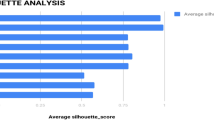Abstract
The amount and diversity of mobile and IoT location and trajectory data are increasing rapidly. As a consequence, there is an emerging need for flexible and scalable tools for analyzing this data. In this work we focus on an important building block for analyzing location data, that is, the problem of partitioning a space into regions of interest (ROIs) that are densely visited. The extraction of ROIs is of great importance as it constitutes the first step of many types of data analysis on mobility data, such as the extraction of trajectory patterns expressed in terms of sequences of ROIs. However, in this paper we argue that unconstrained ROIs are not meaningful and useful in all applications. To address this weakness, we propose the problem of constraint-based ROI mining, and identify two types of constraints: intra- and inter-ROI constraints. Subsequently, we propose an integer linear programming formulation of the task of discovering a fixed number of constrained ROIs from a binary density matrix. We extend the approach to discover automatically the number of ROIs by relying on the Minimum Description Length Principle. Our experiments on real data show that the approach is both flexible, scalable and able to retrieve constrained ROIs of higher quality than those extracted with existing approaches, even when no constraints are imposed.
Access this chapter
Tax calculation will be finalised at checkout
Purchases are for personal use only
Similar content being viewed by others
Notes
- 1.
The Python code of our model is accessible here https://github.com/AlexandreDubray/mining-ROI.
- 2.
The data set can be downloaded at this link https://www.kaggle.com/crailtap/taxi-trajectory/home. We filtered out incomplete trajectories and the few trajectories that went too far away from Porto.
References
Agrawal, R., Srikant, R.: Mining sequential patterns. In: IEEE International Conference on Data Engineering (ICDE), vol. 95, pp. 3–14 (1995)
Alvares, L.O., Bogorny, V., Kuijpers, B., de Macedo, J.A.F., Moelans, B., Vaisman, A.: A model for enriching trajectories with semantic geographical information. In: GIS (2007)
Ankerst, M., Breunig, M.M., Kriegel, H.P., Sander, J.: OPTICS: ordering points to identify the clustering structure. ACM SIGMOD Rec. 28(2), 49–60 (1999)
Aoga, J.O.R., Guns, T., Schaus, P.: An efficient algorithm for mining frequent sequence with constraint programming. In: Frasconi, P., Landwehr, N., Manco, G., Vreeken, J. (eds.) ECML PKDD 2016. LNCS (LNAI), vol. 9852, pp. 315–330. Springer, Cham (2016). https://doi.org/10.1007/978-3-319-46227-1_20
Belcastro, L., Marozzo, F., Talia, D., Trunfio, P.: G-ROI: automatic region-of-interest detection driven by geotagged social media data. TKDD 12(3), 1–22 (2018)
Cai, G., Hio, C., Bermingham, L., Lee, K., Lee, I.: Sequential pattern mining of geo-tagged photos with an arbitrary regions-of-interest detection method. Expert Syst. Appl. 41(7), 3514–3526 (2014)
Ester, M., Kriegel, H.P., Sander, J., Xu, X., et al.: A density-based algorithm for discovering clusters in large spatial databases with noise. In: KDD (1996)
Giannotti, F., Nanni, M., Pinelli, F., Pedreschi, D.: Trajectory pattern mining. In: SIGKDD (2007)
Gorawski, M., Jureczek, P.: Regions of interest in trajectory data warehouse. In: Nguyen, N.T., Le, M.T., Świątek, J. (eds.) ACIIDS 2010. LNCS (LNAI), vol. 5990, pp. 74–81. Springer, Heidelberg (2010). https://doi.org/10.1007/978-3-642-12145-6_8
Kalra, T., Mathew, R., Pal, S.P., Pandey, V.: Maximum weighted independent sets with a budget. In: Gaur, D., Narayanaswamy, N.S. (eds.) CALDAM 2017. LNCS, vol. 10156, pp. 254–266. Springer, Cham (2017). https://doi.org/10.1007/978-3-319-53007-9_23
Li, Q., Zheng, Y., Xie, X., Chen, Y., Liu, W., Ma, W.Y.: Mining user similarity based on location history. In: SIGSPATIAL. ACM (2008)
Monreale, A., Pinelli, F., Trasarti, R., Giannotti, F.: Wherenext: a location predictor on trajectory pattern mining. In: SIGKDD. ACM (2009)
Palma, A.T., Bogorny, V., Kuijpers, B., Alvares, L.O.: A clustering-based approach for discovering interesting places in trajectories. In: SAC (2008)
Rissanen, J.: Modeling by shortest data description. Automatica 14(5), 465–471 (1978)
Ying, J.J.C., Lee, W.C., Weng, T.C., Tseng, V.S.: Semantic trajectory mining for location prediction. In: SIGSPATIAL. ACM (2011)
Yuan, J., Zheng, Y., Xie, X., Sun, G.: Driving with knowledge from the physical world. In: SIGKDD. ACM (2011)
Yuan, J., et al.: T-drive: driving directions based on taxi trajectories. In: SIGSPATIAL. ACM (2010)
Yuan, N.J., Zheng, Y., Zhang, L., Xie, X.: T-finder: a recommender system for finding passengers and vacant taxis. IEEE TKDE 25(10), 2390–2403 (2013)
Author information
Authors and Affiliations
Corresponding author
Editor information
Editors and Affiliations
Rights and permissions
Copyright information
© 2020 Springer Nature Switzerland AG
About this paper
Cite this paper
Dubray, A., Derval, G., Nijssen, S., Schaus, P. (2020). Mining Constrained Regions of Interest: An Optimization Approach. In: Appice, A., Tsoumakas, G., Manolopoulos, Y., Matwin, S. (eds) Discovery Science. DS 2020. Lecture Notes in Computer Science(), vol 12323. Springer, Cham. https://doi.org/10.1007/978-3-030-61527-7_41
Download citation
DOI: https://doi.org/10.1007/978-3-030-61527-7_41
Published:
Publisher Name: Springer, Cham
Print ISBN: 978-3-030-61526-0
Online ISBN: 978-3-030-61527-7
eBook Packages: Computer ScienceComputer Science (R0)




